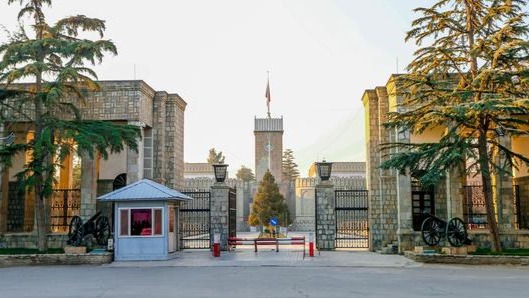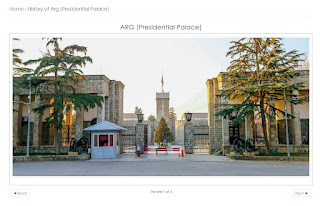經分析,應該是坐東南朝西北,後方花園庭院~2021五黃東南
Ι Arg Library Ι Arg Mosque Ι Haram Sara Ι Kuti Baghcha
Salaam Khana Palace Ι Dilgosha Palace Ι Char Chenar Palace Ι Clock Tower Of Dilgosha
Kabul, a city of ancient history, had been a home for kings and crowns. In the past, a wall, which still its remainders exist, enclosed the city with six entrance gates. Each of the doors were known with a certain name, Kandahari Gate in Dehmazang area, Sardar Jahan Khan Gate at Salam Khaana area, Speena Darwaza, Peet Darwaza behind Eidgah Masjid, Guzargah gate at Bala Hesar as well as Lahoori Gate which old people still express their memory lanes about.
The ruling castle was situated at Bala Hesar. Before kingdom of Abd-ur-Rahman Khan, no suitable place was available for the king. Bala Hesar and Shir Poor palaces had been damaged and partly burned during the wars in Afghanistan. During the reign of Shir Ali Khan, construction of Shir Poor Castle had been started in accordance with his order, but in 1878, following the attack of English to Kabul, the King moved away to Mazar-e-Sharif and the construction was stopped.
By the time, Amir Abd-ur-Rahman Khan came to Kabul and ascended the throne, there was no suitable place for residence of the king. Therefore Amir spent the first night at house of Ghazi Abdullah Khan Wardak who was dwelling in the area today known as Da-Afghanan.
King Abd-ur-Rahman Khan developed a plan to build the Arg palace in 1229 Hijri Qamari. The King paid a visit to Jalalabad to organize military affairs and stayed there for a while. Amir – the king – sent a letter to his son and instructed him to commence building of the palace in coordination with advisors at the area which is located today. At last, construction of the palace was started by a number of adept and proficient architects in 1300 Hijri Qamari.
There was no trace of a constructed area in nowadays Arg (the Presidential Palace) and it was only a soil dessert. There were farms and gardens on a part of the area surrounded by dry lands. There was also a small bazar in present-day Da-Afghanan and Wazir Akbar Khan neighborhood was an open area in which, afterwards, the first airport was founded during the reign of Ghazi Amanullah Khan.
Construction of the Arg was coincided with creation of several other buildings. Bostan Saray is located in current Zarnegar Park where Amir Abd-ur-Rahman Khan is laid to rest today. The other building ‘Gulistan Saray’, in which Amir Abd-ur-Rahman khan had been living, was situated across from Ministry of Education on the area where currently Kabul Municipality is positioned. Two mentioned buildings were parts of the Arg in that time.
Currently, some portions of the Arg do not exist on the map of Kabul city. Some of these buildings have been demolished and some renovated and still remain. Right now, the mentioned buildings are differently situated inside and outside of the Arg. For instance, Storay Palace is situated in Ministry of Foreign Affairs and Naak Bagh Palace is positioned in National Archive. Zain-ul-Emaarat Palace is referred to the current Sedarat (Presidency) which was built by Viceroy Nasrullah Khan.
In aspect of location, the Arg palace is located at the heart of Kabul linked to Da Afghanan in east and to Murad Khani area in north-west. From Pashtunistan Square to Macrorayan, Ministry of Mines, Administrative Office of the President and Ministry of Defense are situated at the side of the road in front of the Arg palace. Also, Ariana Square, Ariana Hotel and Central Statistics Department are positioned in north-east. Amani High School and residential houses of Wazir Akbar Khan are positioning at side of a road passed through the north side of the Arg palace. The west side has comprised Ministry of Foreign Affairs, Embassy of China as well as the United Nations Offices, and finally Azizi Center and other building have been raised to the south.
The first building constructed inside the Arg palace is called Kuti Baghcha of which construction was completed on 1304 Hijri Qamari. Following that, several buildings were constructed such as; the building of ARG, Salaam Khaana Palace, Gunbad (Dome) of Naghara Khaana, Arg Kootwali Bazar, Shahi Base (Qaraargah Shahi), Shahi therm (Hamam Shahi) and Office of Accountant for the Countries (Mostofi-ul-Mamalek).
Other Palaces
A number of other palaces were built during the reign of Amir Abd-ur-Rahman Khan along with construction of the Arg Palace.
Kuti Baghcha
Kuti Baghcha known as the first palace inside the compound, is a round two-floor building built on a 300 m2 area. The palace comprises a total number of 15 small, medium and large rooms. The second floor contains small but spectacular rooms which its windows are opened to numerous directions.
Prior to coup against Sardar Dawood Khan, Sardar Abdul Wali Khan was living in Kuti Bachcha. It is expressed that sacred hair of the Prophet Muhammad (Peace Be Upon Him) has been found on eastern room of the second floor. It is worth mentioning that a part of the palace had served as a museum, and Shahi Kitchen used to exist on south-east of the palace. Construction process of Kuti Baghcha came to an end in 1304 Hijri Qamari.
海外网7月20日电 据法新社援引阿富汗当地媒体报道,当地时间20日,位于阿富汗首都喀布尔的总统府疑似遭到袭击,有火箭弹落在总统府附近。(海外网 汪晓宇)






沒有留言 :
張貼留言